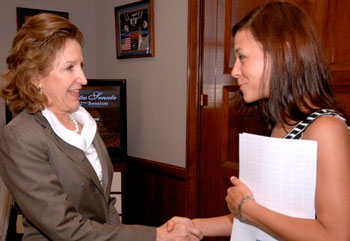Grass-Roots Advocacy
| Arts advocates are people who work to educate their communities about important issues. It's really as simple as that. And with a clear, consistent message, you can make your case resonate with those who make policy decisions. |  |
 The Advocate's Role
The Advocate's Role
Contrary to popular opinion, advocates are not necessarily high-paid, Washington lobbyists who hold Congress in one pocket and the President in the other. In fact, advocates are simply people who work to educate their communities about important issues. In order to be supported by members of Congress and the Executive Branch, nonprofit arts institutions must be strong and consistent advocates for issues affecting the arts community.
In the current political climate, the role of Washington lobbyists has been greatly diminished to make way for the voices of voters across the country. It is an exciting time in which visits, phone calls and letters from people in Representatives' districts and Senators' states have a much greater impact in Washington than in previous years. However, this shift also means that in order to place arts issues high on the national agenda, nonprofit institutions and their supporters must make themselves heard by their Senators and Representatives.
The National Assembly of State Arts Agencies (NASAA ) has many publications that can assist in your work:
- To learn how to strengthen your relationships with legislative leaders, consult Access to Power: Building Political Clout for the Arts.
- For ideas on how to maximize contacts with your legislators and expand your advocacy clout, consult Forty Action Strategies.
- To see how you can broaden the reach of public arts funding by connecting the arts to a variety of public policy issues, consult The Arts in Public Policy: An Advocacy Agenda.
- For help with turning your board members into advocates, consult Advocacy for Public Support of the Arts: A Civic Responsibility.
- To learn how nonprofit arts organizations can lobby without risk to their tax status, consult Advocacy by Arts Organizations: Tax Laws and Lobbying.
- These and other free publications may be found on the NASSA Advocate page.
- Other resources may be found on the NASSA's website's "Advocacy Tools" page.
 Working with the Media
Working with the Media
Letters to editors, feature articles in your city's newspapers and appearances on local talk radio or television shows offer excellent opportunities to highlight your contributions to your community. Part of your role as an advocate is to "create" other advocates by encouraging enthusiasm for the arts. Using local media to generate enthusiasm about your institution's artistic mission, outreach efforts and other special programs helps develop support for the arts overall. Legislators carefully read the papers from their districts in order to monitor constituents' concerns. The more visible the arts are in your local press, the more visible the arts will be to your legislators.
Following are basic tips on how to use the media in your community:
- Letters-to-the-editor and op-ed pieces are among the best ways to get your message across and to communicate both with your community and legislators. Make sure your submissions are concise and easy to understand.
- Respond immediately to negative press (articles, editorials or letters-to-the-editor) on priority arts-related issues.
 Delivering the Message
Delivering the Message
State the purpose of your visit, letter, or Op-Ed: Emphasize your concerns about the future of the NEA and government support for the arts in other policy areas including: tax laws that encourage private giving; the arts as central to a basic and effective education; access to the information superhighway; and non-profit postal rates.
Provide information about your group: Describe your institution/organization (e.g. variety of performances/exhibits; types of community outreach programs; size of audience base; data on how the institution stimulates the local economy through jobs, purchases from local businesses, etc.)
Ask for the member's support: Encourage your member to be a strong voice in support of the arts, including the NEA, and in the policy areas such as tax, arts education, telecommunications and postal.
Message Highlights:
 The Arts as an Economic Investment in Your Community:
The Arts as an Economic Investment in Your Community:
- Note current local trends in public and private funding.
- The arts create jobs, increase the tax base, boost tourism, and spur growth in related businesses (e.g. hotels, restaurants, printing, etc.)
- For example, last year, $98 million in NEA grants leveraged more than $1.3 billion in matching funds.
- Private donations (which vary from year to year) or increased ticket prices (which would undermine arts institutions' mission to reach a broader audience) will not be able to replace a loss of federal funding.
 The Arts are an Investment in Our Children:
The Arts are an Investment in Our Children:
- Artists and nonprofit arts institutions/organizations are an investment in our children's future and improve their quality of life through excellent artistic programming and extensive educational and community outreach activities.
- The arts create better students. Research indicates that the arts stimulate learning and creativity, improve overall academic performance, develop problem-solving skills, teach discipline, promote team work and enhance self-esteem. These skills are invaluable if our next generation is to compete in the technologically advanced global community.
- As the arts continue to be cut from school curriculum, the NEA has put thousands of artists in classrooms in every state.
 The Arts are an Investment in our Communities and Families:
The Arts are an Investment in our Communities and Families:
- Since 1965 (the year the NEA began), the number of symphony orchestras has doubled; theater and dance companies each have grown seven-fold; and opera companies have more than quadrupled.
- Arts institutions bring families and communities together through: children's, Shakespeare and music festivals; rural music tours; outdoor summer concerts; free and reduced tickets for concerts and plays; and mobile museums for rural and inner-city areas.

